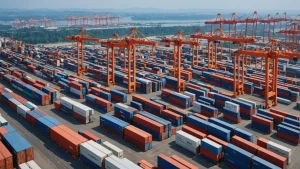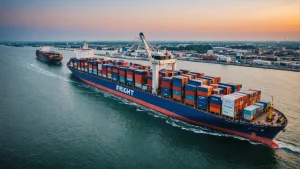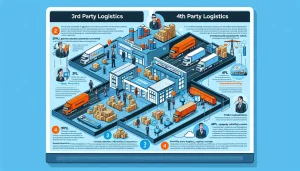Crack the code of modern logistics. 3PL vs 4PL: it’s a battle of the titans in business logistics for 2024.
Navigating the labyrinth of logistics can seem like battling endgame bosses in an MMORPG. If that’s how you feel, then you’re not alone. No surprise there, with first-party logistics, second-party logistics, 3rd and 4th party logistics involved, it’s a complicated game, especially when it comes down to improving your business operations. Curious about third-party logistics and how it fits into this complex maze? Discover the benefits and drawbacks of integrating 3pl logistics solutions into your business strategy.
But, fret not.
This guide breaks down the distinction between 3PL and 4PL, helping your business sail smoothly on its journey in 2024. Decrypt the intricacies of modern, logistics models, unlocking new insights and potential for your business growth. Buckle up, it’s going to be quite a ride. Eager to delve deeper into the role of freight forwarding in these logistics models? Learn how forwarding services play a pivotal role in streamlining your business’s supply chain.

Earn $1,200+/week delivering for local businesses
Driver benefits:
- Steady local business routes
- Weekly pay + tips
- Dedicated support team
- Flexible scheduling
Understanding 3PL and 4PL: The Core Differences
Coming straight out of the introduction, we’ll examine and clarify Third-Party Logistics (3PL) and Fourth-Party Logistics (4PL).
Defining Third-Party Logistics: What Does It Mean for Your Business?
Firstly, let’s delve into Third-Party Logistics (3PL). It’s a vital entity in the business landscape, particularly in supply chain management.
3PL refers to companies that provide outsourced logistics services to businesses. They may take care of everything – warehousing, transportation, packing, and inventory management for shipping companies. For businesses, this means smoother operations, less hassle, and the chance to focus on their core activities. Curious about how third-party logistics (3pl) can optimize your business operations? Discover the advantages and challenges of incorporating 3pl logistics into your business strategy.
You might wonder how 3PLs slot into the whole logistics model and supply chain management. Well, they’re essentially the cog in the machine that makes it all work. As a link between manufacturers and retailers, they streamline the product journey, right from the factory to the store. This helps businesses maintain efficiency, reduce costs, and keep customers happy – a trifecta of benefits that successfully manage logistics and supply chains to drive commerce.
Defining 4PL: How It Transforms Your Business Operations?
Now, let’s switch gears to Fourth-Party Logistics (4PL). It’s one step further than 3PL and offers an even deeper degree of outsourced logistics service.
4PL is typically a separate entity established by a joint venture or long-term contract between a primary client and one or more partners for specific logistics functions. It’s like a conductor of an orchestra, coordinating all aspects of the supply chain, including logistics operations, technology, and resources. Explore what additional services in logistics can do for you: Learn how they can elevate your 4PL partnership and boost overall supply chain efficiency.
In terms of supply chain management, 4PL’s role cannot be overlooked. It offers an end-to-end supply chain solution, which means it takes responsibility for the entire logistic process, from strategy and planning to execution. They can potentially revolutionize how a business operates, by integrating advanced technology, for better visibility, creating efficiencies, and reducing costs through strategic decisions. Thus, 4PL can help you gain a competitive edge in today’s dynamic market.
Key Differences Between 3PL and 4PL
Finally, let’s dissect the disparities between 3PL and 4PL. It’s like comparing apples and oranges – similar in some ways, unique in others.
The primary key difference lies in the level of involvement and control. While 3PLs handle specific logistics operations, 4PLs are more involved, taking control of the client’s entirety of logistics, including managing 3PLs and coordinating resources, technology, and infrastructure.
Next, 4PL provides strategic insights, not merely services. They use data analytics and advanced technology, to glean valuable information from the supply chain, fostering wise decisions and long-term improvements. Yet, 3PLs might not typically offer this comprehensive management and analytical perspective.
Also, the cost differs–4PL’s holistic service usually comes at a higher price compared to 3PL. But many businesses find it’s worth every penny for the benefits gained.
At the end of the day, the decision to opt for 3PL or 4PL boils down to individual business needs – the size of your operations, your goals, resources, and budget.
Benefits of 3PL for Businesses: Why It Might Be the Right Choice for You
Cost-Effective Solution for Logistics Management
3PL services prove to be a cost-saving option for logistics management. Businesses get to enjoy the benefits of expert-driven logistics, without the expenses of maintaining an in-house department. 3PL logistics services providers leverage their industry experience and large-scale logistical operations to negotiate better deals with carriers, resulting in operational cost savings for businesses.
It’s not just about saving dollars on freight expenses. With a 3PL provider in place, businesses can reduce their inventory holding costs and overall logistics overhead. The idea of economies of scale comes into play: as the volume of freight to be managed increases, the per-unit cost decreases.
Profitability in 3LP Logistics
79% of 3PLs have reported improved profitability in the last year and 33% indicated high profitability growth.
Expertise in Logistics and Entire Supply Chain Management
3PLs bring a wealth of knowledge and experience to the table. They have a deep understanding of the intricacies of the supply chain and current trends in logistics, which they bring to bear on behalf of the businesses they serve. Their proficiency in the field can help strategize and streamline logistics, ensuring a smooth flow of operations, reduced delays, and optimized inventory management.
For instance, a motor parts logistics company, Ace Motors, decided to hire a 3PL service provider. The experts from the 3PL firm analyzed Ace Motors’ supply chain and the logistics company implemented new logistics plans, which eventually sped up their shipping times and reduced warehousing needs.
The Global 3PL Market
The global 3PL market is expected to grow to USD 1,993.72 billion by 2028.
Flexibility and Scalability
The hallmark of a good 3PL provider is their ability to cater to changing business needs. With seasonal fluctuations, changing customer demands, or rapid business scaling, a 3PL logistics provider, can adjust the supply chain processes accordingly. This is because of their vast network of resources, which can be stretched or shrunk as per requirement to meet customer demand. Essentially, businesses that lead logistics providers have the agility to grow and adapt without significant investments in warehouses, vehicles, or personnel.
Thus, whether a company needs to navigate the Christmas rush or tap into a new market territory, a powerful 3PL provider can flex its logistic capabilities to match the changing scenario. Apart from the obvious convenience, this flexibility also insulates businesses against economic downturns or sudden market disruptions. Businesses can react quicker and withstand hiccups much better with a capable 3PL by their side.
This section has highlighted the benefits of 3PL in terms of cost-effectiveness, expertise, and flexibility. As a business, the opportunity to leverage these advantages could greatly enhance your logistics operations.
3LP Logistics Statistics
3PLs are expected to reach US $2,144 billion by 2032, with a 7.6% compound annual growth rate (CAGR) from 2022 to 2032.
Advantages of 4PL for Businesses: Taking Your Operations to the Next Level
The Global Fourth Party Logistics Industry
The global fourth-party logistics industry generated $57.9 billion in 2021 and is anticipated to reach $111.7 billion by 2031, with a compound annual growth rate (CAGR) of 6.7% from 2022 to 2031
Comprehensive Control Over the Supply Chain
4PL offers businesses a crucial advantage: complete control over the entire supply chain process. This comes from the sheer scope of involvement a 4PL provider has in a business’s entire logistics operations. Think of it as getting a helping hand that reaches into every corner of your supply chain. Discover how integrating your supply chain with a 4PL provider can redefine efficiency and control within your logistics operations.
4PL providers work on behalf of a client, handling data, managing suppliers, transportation, warehousing, and in some cases, even making business decisions. This means that businesses can focus on core competencies while their logistics activities are managed by a dedicated third or fourth-party logistics.
In essence, a 4PL provider becomes a ‘one-stop-shop’ for all of a company’s logistics needs. This results in streamlined processes, reduced operating costs, and increased efficiency.
Strategic Insights and Analytics
In today’s data-dominated landscape, overlooking the power of logistics analytics can be a significant, if not fatal, mistake for businesses. 4PL providers can play a game-changing role by offering detailed analytics and strategic insights.
4PL providers employ various tools to collect, process, and analyze logistic data. This data can reveal trends, inefficiencies, and opportunities in the supply chain operations that might not be immediately apparent. Furthermore, businesses can use this data to make informed strategic decisions, improving overall operations. Digging into this data goldmine can lead to significant cost savings and operational efficiencies.
While the scale and complexity of this data may be overwhelming for businesses, for a 4PL provider, it’s another day at the office. Here’s where their expertise becomes invaluable. They can take these vast datasets, analyze them, and present you with actionable insights, aiming to enhance the supply chain efficiency.
4PL Logistics Statistics
The industry innovator model segment in 4PL logistics is projected to manifest the highest CAGR of 11.2% from 2022 to 2031
Enhanced Customer Service
The impact of 4PL on customer service cannot be overstated. From ensuring timely deliveries to tackling complex supply chain problems, the role of a 4PL provider is essential in delivering a superior customer experience.
Remember, the customer experience doesn’t stop at the point of sale; it includes the entire journey from placing an order to receiving the product. Here, a successful supply chain plays a pivotal role, and thus, having a professional 4PL provider at your service can indeed boost customer satisfaction.
Furthermore, by leveraging strategic insights from the previous point, 4PL providers can predict potential supply chain disruptions. Various mitigation strategies can be implemented to handle any potential issues, thus ensuring a smooth customer experience and ensuring customer loyalty.
Choosing Between 3PL and 4PL: Making the Right Decision for Your Business
Assessing Your Business Needs
Every company has unique logistical needs. One size does not fit all. The first step in deciding whether to go with a 3PL or a 4PL provider is to assess your business needs. This process can be daunting, so break down your requirements into tangible criteria. Start by identifying your volume, range of products, global reach, and technological needs. Discover the critical role of a coordinator in logistics and how they can streamline your business’s supply chain operations by efficiently managing these requirements.
Factors to consider when choosing between 3PL and 4PL
Each type of party logistics provider brings its own set of advantages. While 3PL providers generally offer more control and hands-on management, 4PL providers bring integration and coordination to the logistics process, acting as a single point of contact. Weigh your need for control against your need for integrated coordination to pinpoint which provider will best meet your requirements—especially important when evaluating the benefits of global expansion and scaling logistics internationally.
Evaluating the Cost and Value Proposition
Understanding the cost and value proposition of both 3PL and 4PL providers is critical to making an informed decision. This will allow you to determine the return on investment (ROI) you can expect from either service.
Comparison of the cost and value proposition of 3PL and 4PL
While 4PL might seem expensive in comparison to 3PL, keep in mind the broader picture. 4PL manages and integrates all resources, capabilities, and technology needed for a complete supply chain solution. This comprehensive approach provides value and may lead to cost savings in the long run. Conversely, 3PLs’ more compartmentalized offering may appeal to those preferring to handle specific aspects of their logistics internally.
Considering the Long-Term Impact
Any decision made today regarding your logistics partner or other logistics providers will have a far-reaching impact on your supply chain management. Thus, it is prudent to consider the long-lasting effects of this choice. If you’re in search of premier third-party logistics providers to enhance your supply chain management, explore the finest options that guarantee steadfast logistics assistance for your enterprise.
How the choice between 3PL and 4PL can impact your business in the long run
Choosing a 3PL or 4PL is not just a short-term tactical decision but a strategic one with long-term implications. Choosing a 3PL might mean retaining more control but also additional management responsibilities. On the other hand, opting for a 4PL could mean delegating much of your supply chain’s complexity but potentially at a higher cost. Hence, reflect on these factors and consider the potential implications for your business model, competitive positioning, and growth plans.
Remember, you have to choose not just for today, but also for your business’s future.
3PL vs 4PL
3PLs handle specific logistics tasks like warehousing, while 4PLs manage the entire supply chain, offering strategic guidance and optimization.
Impact of 3PL and 4PL on Supply Chain Management: Transforming Your Business Operations
Role of 3PL in Supply Chain Management
It’s no secret that Third-party Logistics (3PL) are the backbone of many successful supply chains. They tide logistics companies over challenges, be it long warehouse leasing contracts or hefty courier rates, frequently faced by businesses. Essentially, 3PLs come to the rescue of organizations that need an extra pair of hands to manage their supply chain activities and logistic requirements efficiently and economically.
How 3PL can enhance supply chain management
Let’s clear the air. 3PL isn’t just about transportation services and warehouse management. It offers many more services such as order fulfillment, inventory forecasting, and reverse logistics, to name a few. By providing these services, 3PL partners take away the brunt of logistics management, freeing up precious time and resources for businesses to target their core competencies.
Role of 4PL in Supply Chain Management
It’s interesting how Fourth-party Logistics (4PL) amplifies what 3PL achieves by a nautical mile. As the Outsourcing Institute conceptualizes it, 4PL is the Uber of logistics—a holistic solution to all logistics needs.
How 4PL can revolutionize supply chain management
Imagine a soothsayer who also takes actionable steps to control the future! That’s precisely 4PL’s role in a supply chain. It leverages its access to a wide range of logistic resources coupled with advanced analytics to predict challenges and preemptively address them, thus streamlining the entire supply chain management process.
Future Trends in 3PL and 4PL
Now that you’ve unearthed what 3PL and 4PL bring to your business table, it’s time to gaze at what the future of the logistics model will look like.
Upcoming trends in 3PL and 4PL that businesses should be aware of
From a heavier reliance on data-driven decisions to the growing popularity of robotic process automation, several trends are set to reshape the 3PL and 4PL landscape. Businesses need to keep a vigilant watch on these trends to ensure they navigate the future of the logistics landscape successfully.
Bridging the Gap: Key Considerations To Propel Your Business Forward
Whether it’s utilizing the industry expertise and autonomy of a 3PL, or harnessing the expanded capabilities and comprehensive oversight of a 4PL, it’s essential to nail down your own assets and logistics strategy.
These key players in your supply chain can increase efficiency, improve customer satisfaction, and reduce overhead. The choice between 3PL and 4PL lies in understanding the unique needs and growth goals of your business.
Considering deploying a logistics solution? Take a moment to reflect on your overall business model, scalability needs, and current financial status before committing.
But, how compatible is your business model with outsourcing of specific logistics services? Does the long-term growth of your company lend itself more to a 3PL or a 4PL solution? Reflect on these questions, and make empowered decisions to advance your business.






























